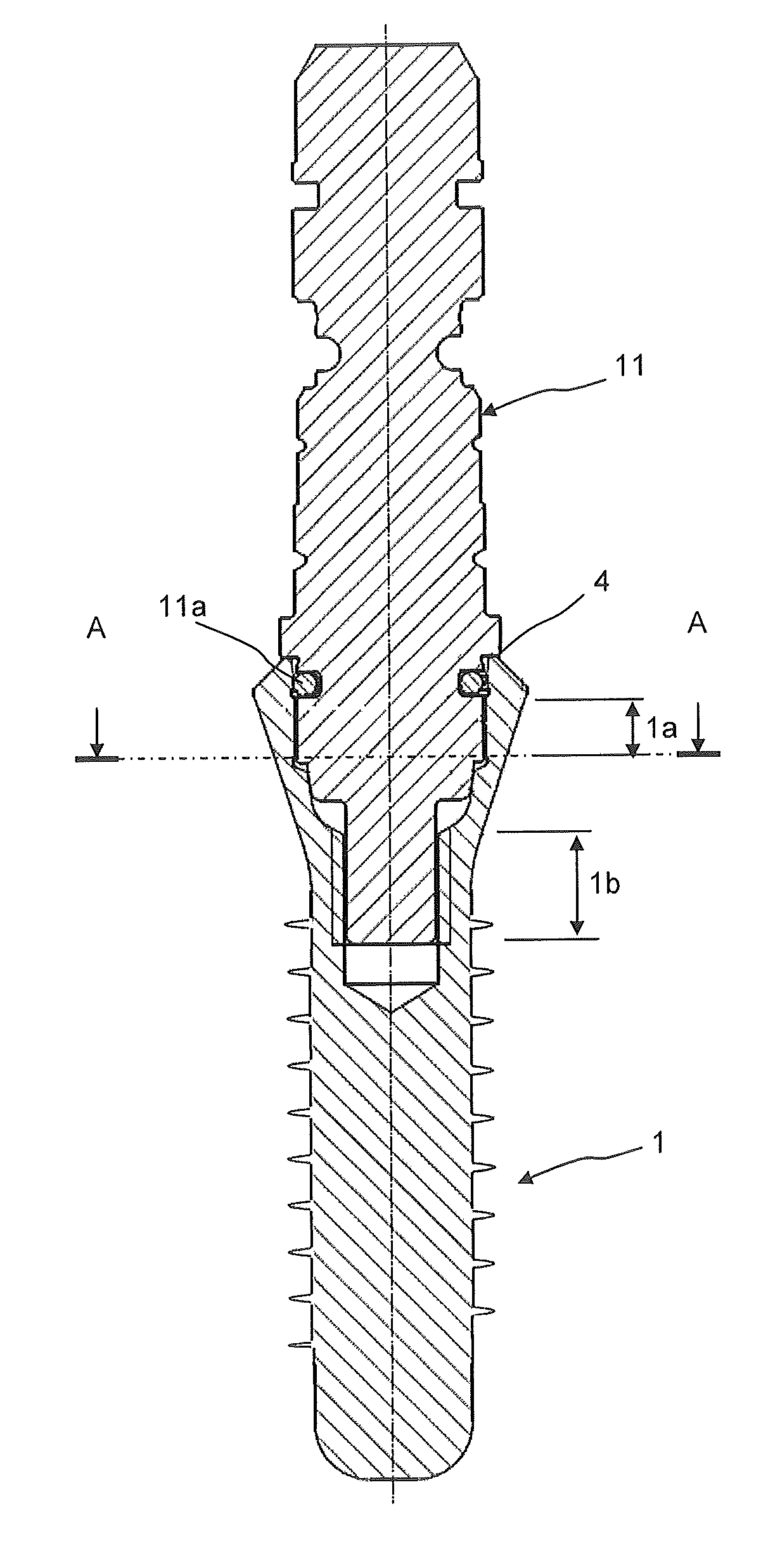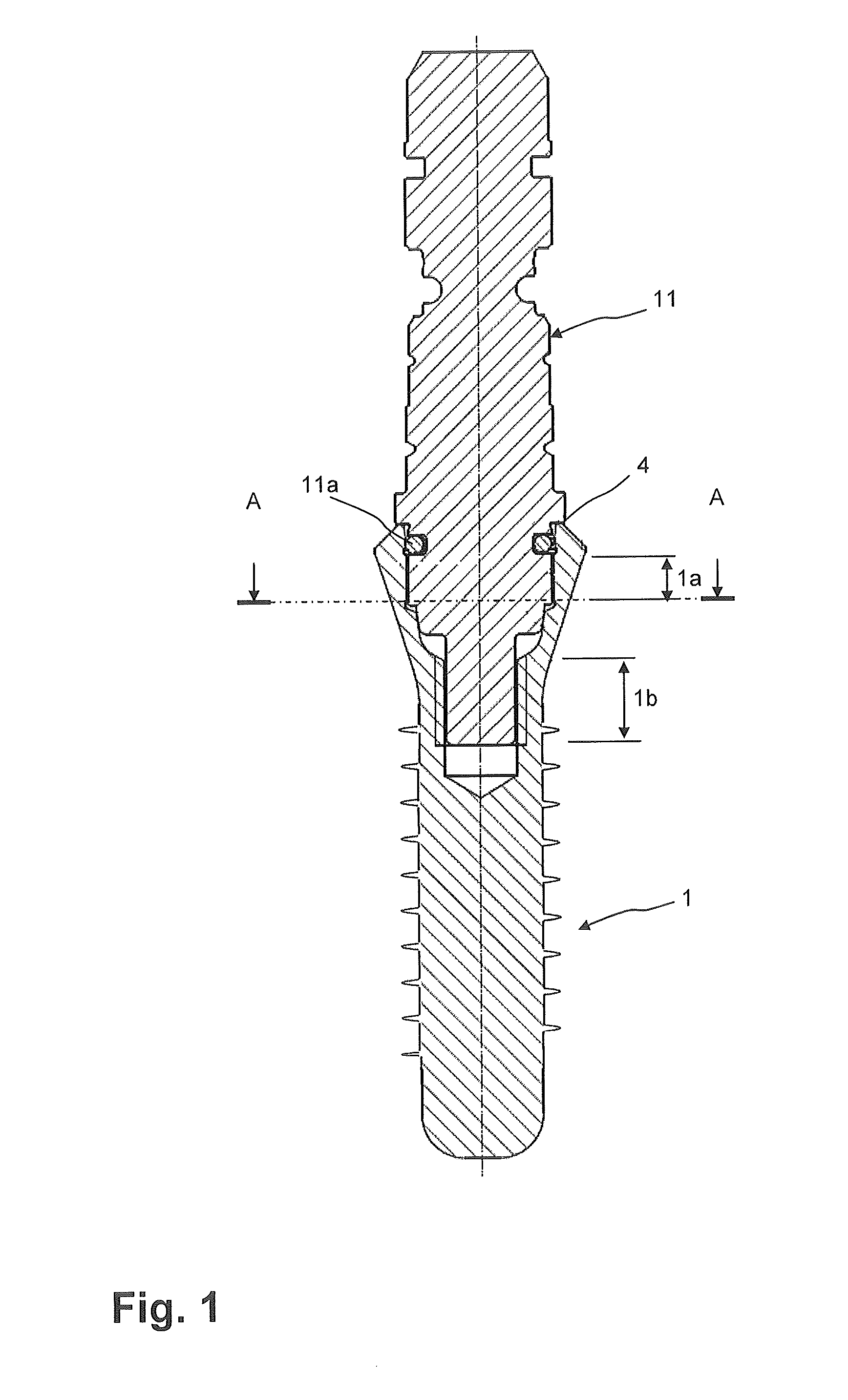Dental implant socket arrangement
- Summary
- Abstract
- Description
- Claims
- Application Information
AI Technical Summary
Benefits of technology
Problems solved by technology
Method used
Image
Examples
first embodiment
[0034]FIGS. 2a to 2d show variations of the invention along a cross-sectional top view of dental implants taken along line A-A of FIG. 1, which are reduced to the representation of a cross-section of the socket arrangement at the bottom of the first and the second section. For the sake of clarity it should be noted that FIGS. 2a to 5b show cross-sectional discs cut out from the implant 1 perpendicular to its longitudinal axis.
[0035]The first section of the socket arrangement defines first contact surfaces 3 having partly a cross-sectional shape of a polygon and preferably a regular polygon. The first contact surfaces 3 are extending from the coronal end downwardly in apical direction of the longitudinal center axis of the implant 1 along the height 1a of the socket, and are parallel to the longitudinal axis of the implant. Nevertheless, the first contact surfaces 3 may be partly cut out by inclined parts or truncated conical sections 3b, the truncated conical sections (3b) forming p...
third embodiment
[0046]Preferably, in the variations of the third embodiment, the two contact surfaces 2a and 2b are connected by a transition section (not shown) bridging the two surfaces in a way that the no acute angles are existing in the corners between contact surface 2a and 2b. The transition section is preferably curved.
[0047]This arrangement of the second contact surfaces 2a, 2b is less advantageous as compared with the rectangle notches 2 with respect to the forces applied by the ribs of the insertion tool 11. The force vector of torque is not perpendicular to the contact surfaces 2a and 2b, but oriented at a lower angle, which is more unfavorable with respect to jamming / welding of the insertion tool during implant insertion. As compared to the shape of notches 2 or ridges represented in FIGS. 2a to 3d, the shape of the notches 2 or ridges of the embodiments of FIGS. 4a to 4b ensures a minimal removal of material from the original contact surface 3. Therefore, a higher stability of the imp...
fourth embodiment
[0050]Another modified embodiment (not shown) with similar features to those of said fourth embodiment of FIGS. 5a to 5b, but wherein the trapezoidal shape is tapered in radial direction inwardly, is also imaginable. The latter variation has a better perpendicular shape in terms of the applied forces from the ribs of the insertion tool 11. The embodiment with inwardly tapered notches 2 with the second contact surfaces 2a, 2b perpendicular to the applied forces prevent a welding of the contact surfaces which would otherwise weld the contact surfaces if applied with a high tangential component.
[0051]In all described versions of the third and fourth embodiment shown in FIGS. 4a to 5b the angle between contact surface 2a and 2b can range between 30° and 90°, whereby the risk of welding the notches 2 and ridges during torque transmission increases with increasing angle.
[0052]FIGS. 2a to 5b show either four, six or eight notches 2 or ridges either located at sides of contact surface 3 or ...
PUM
 Login to View More
Login to View More Abstract
Description
Claims
Application Information
 Login to View More
Login to View More - R&D
- Intellectual Property
- Life Sciences
- Materials
- Tech Scout
- Unparalleled Data Quality
- Higher Quality Content
- 60% Fewer Hallucinations
Browse by: Latest US Patents, China's latest patents, Technical Efficacy Thesaurus, Application Domain, Technology Topic, Popular Technical Reports.
© 2025 PatSnap. All rights reserved.Legal|Privacy policy|Modern Slavery Act Transparency Statement|Sitemap|About US| Contact US: help@patsnap.com



